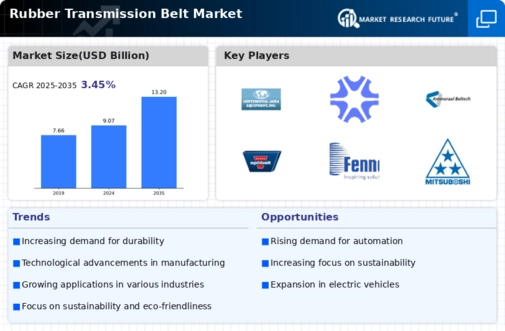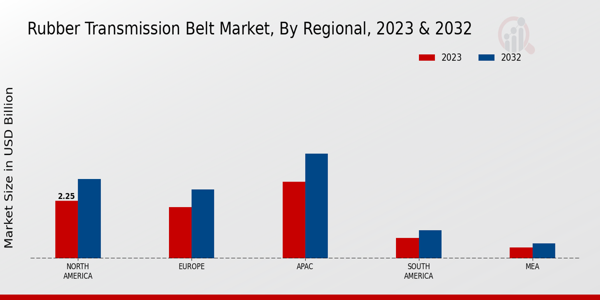Market Trends and Forecasts
Rising Demand in Automotive Sector
The Global Rubber Transmission Belt Market Industry experiences a notable surge in demand driven by the automotive sector. As vehicle production increases, the need for reliable transmission belts becomes paramount. In 2024, the market is projected to reach 9.07 USD Billion, reflecting the automotive industry's recovery and growth. Moreover, advancements in automotive technology necessitate high-performance belts that can withstand increased stress and temperature variations. This trend is expected to continue, with the market projected to grow at a CAGR of 3.45% from 2025 to 2035, reaching an estimated 13.2 USD Billion by 2035. Such growth underscores the critical role of rubber transmission belts in modern vehicles.
Regulatory Standards and Compliance
The Global Rubber Transmission Belt Market Industry is influenced by stringent regulatory standards and compliance requirements. Governments worldwide are increasingly implementing regulations aimed at ensuring product safety and environmental sustainability. These regulations often necessitate the use of high-quality materials and manufacturing processes in the production of rubber transmission belts. Compliance with these standards not only enhances product reliability but also boosts consumer confidence. As industries adapt to these evolving regulations, the demand for compliant rubber belts is likely to increase, thereby fostering market growth. This trend highlights the importance of regulatory frameworks in shaping the dynamics of the rubber transmission belt market.
Growing Demand for Energy Efficiency
The Global Rubber Transmission Belt Market Industry is increasingly shaped by the growing demand for energy efficiency across various sectors. As industries strive to reduce operational costs and minimize environmental impact, the focus on energy-efficient solutions becomes paramount. Rubber transmission belts play a crucial role in enhancing the efficiency of machinery by reducing friction and energy loss during operation. This trend is particularly evident in sectors such as manufacturing and logistics, where energy costs constitute a significant portion of operational expenses. The emphasis on sustainability and energy conservation is expected to drive the adoption of advanced rubber belts, thereby contributing to the market's growth trajectory.
Technological Advancements in Materials
Technological advancements in materials significantly impact the Global Rubber Transmission Belt Market Industry. Innovations in rubber compounds and manufacturing processes enhance the durability and performance of transmission belts. For instance, the introduction of synthetic rubber blends improves resistance to wear, heat, and chemicals, thereby extending the lifespan of belts in demanding applications. This evolution in material technology aligns with the increasing requirements for high-performance belts across various sectors, including automotive and industrial machinery. As manufacturers continue to invest in research and development, the market is likely to benefit from these advancements, leading to improved product offerings and increased market share.
Industrial Automation and Machinery Growth
The Global Rubber Transmission Belt Market Industry is significantly influenced by the expansion of industrial automation and machinery. As industries increasingly adopt automated processes, the demand for efficient transmission systems rises correspondingly. Rubber belts are integral to various machinery, facilitating smooth operation and enhancing productivity. The ongoing trend towards automation in manufacturing sectors, such as food processing and textiles, further propels this demand. This shift not only improves operational efficiency but also reduces downtime, thereby increasing the overall market potential. The anticipated growth in industrial automation is likely to bolster the rubber transmission belt market, contributing to its projected increase in value over the coming years.









